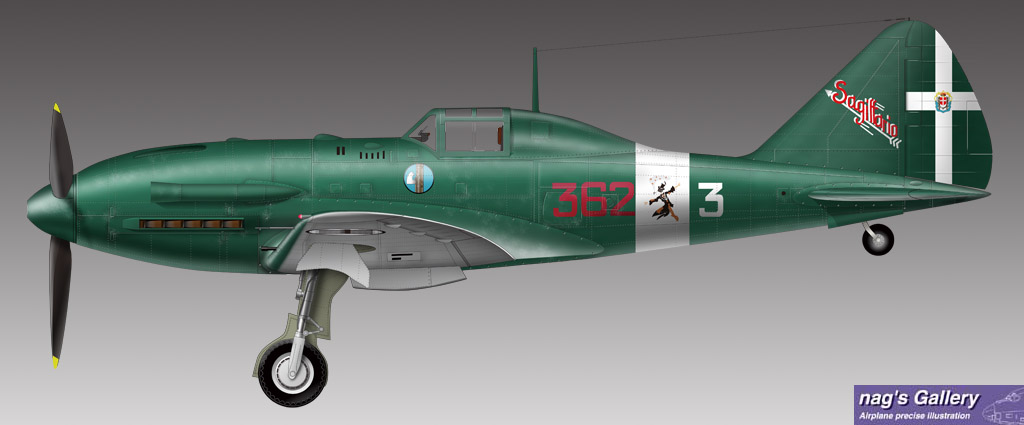G.55

The Italians appear to have been very happy with a specific shape when it came to overall fighter design.
Modifications of the existing Macchi fighters should make airframe modeling easier.
The first Centauro to see operational use was the third prototype. On 21 March 1943, the aircraft was assigned to 20° Gruppo (squadron), 51° Stormo (wing) CT, based on Roma-Ciampino, for operational evaluation. In May, the G.55 followed the unit to Capoterra, near Cagliari having its baptism of fire on 5 June 1943, against Allied aircraft attacking Sardinia. The two first pre-production series flew, respectively, on 10 April and in May 1943. In early June they were assigned to 353a Squadriglia (flight) CT based in Foligno, Umbria, were, until August, were transferred nine more aircraft.[11] Pilots were delighted when they began to receive the new fighter in summer 1943.
On 8 September 1943, the date of Armistice, the Regia Aeronautica had received 35 G.55s. Only one of them flew to southern Italy, accepting the invitation of Maresciallo d'Italia Pietro Badoglio to surrender to Allied forces.
There still is not exact data about the G.55 captured by Luftwaffe or acquired by Aeronautica Nazionale Republicana. About 18 G.55s were acquired by ANR while 12-20, or even 42, according to some reports, were requisitioned by the Luftwaffe.[11] The Centauro entered in service with the ANR; a decision was made to produce 500 G.55s, of which 300 were G.55/I and 200 G.55/II Serie II, armed with five 20 mm MG 151/20s and no machine guns. Only 148 were delivered to the ANR units that, as the number of available G.55s dwindled, were progressively re-equipped with the Bf 109G, of various sub-versions, even though Italian pilots preferred the G.55 with cancellation of production being extremely unpopular.
The first unit in ANR to be equipped with G.55 was the Squadriglia Montefusco, in November 1943, operating from Piemonte until 29 March 1944, when it was absorbed by the 1st Gruppo and transferred in Veneto. The 2nd Gruppo was formed at Bresso. It was initially commanded by Lt Col Antonio Vizzoto, and later by Lt Col Aldo Alessandrini. [14] It had three Squadriglie (the 4th, Gigi Tre Osei, the 5th, Diavoli Rossi, and the 6th, Gamba di Ferro). The unit operated near Milan and Varese until April 1944, then it was transferred near Parma and Pavia, then again near the Lake Garda (Brescia and Verona). At the end of May, the 2° Gruppo gave its G.55s to 1° Gruppo and re-equipped with 46 exI./JG 53 and II.JG 77 Bf 109G-6/R6[14]
With the ANR, the G.55s gave a good account of themselves against Allied fighters like the Spitfires and Mustang.
http://en.wikipedia.org/wiki/G-55Re.2005

Though more differences can be seen than in the G.55, the basic shape is still there.
The first pilot to use the Re. 2005 for operational duty was Maggiore Vittorio Minguzzi, commander of 22o Gruppo. The unit was based at Napoli-Capodichino airfield for the defense of the city. Minguzzi received the prototype of the Re.2005 (MM.494) — after flight test evaluations in Guidonia — and made the first flight with this aircraft on 7 March 1943. He and the most able pilots in the Gruppo flew this prototype until 23 March and they all had a very favourable and enthusiastic impression of it. He then took it to Napoli-Capodichino where it was incorporated into 362a Squadriglia. This unit – commanded by Capitano Germano La Ferla – was the first to be equipped with the Re.2005. [7]
Minguzzi scrambled for the first time in the Sagittario on 24 March, when Naples was attacked and on 2 April he claimed a four-engined B-24 Liberator bomber over the Isle of Ischia. This claim is not verified against corresponding USAAF losses. Italian ace Vittorio Minguzzi was impressed by this aircraft following its tests and combat debut on 2 April 1943. He wrote:
The aircraft is in ideal flying conditions at an altitude of 7,000–7,500 meters and can make repeated attacks on American heavy bombers in all positions and from all directions... I can therefore say that the speed and handling qualities are excellent even at 7,000 meters and that compared to the Macchi 202, the Sagittario made two attacks in the time required by the Macchi C.202 for a single pass.[8]
Grp Cpt. Duncan Smith, DSO DFCA, a British fighter pilot and fighter leader of World War II, greatly respected the Re.2005:
The Re.2005 'Sagittario' was a potent aircraft. Having had a dog-fight with one of them, I am convinced we would have been hard pressed to cope in our Spitfires operationally, if the Italians or Germans had had a few Squadrons equipped with these aircraft at the beginning of the Sicily campaign or in operations from Malta. Fast, and with excellent manoeuvrability, the Re.2005 was altogether a superb aeroplane. Neither the Macchi 205 nor the Bf 109G measured up to the capabilities of the Re.2005 series in manoeuvrability or rate of climb. I think it was easily the best aircraft Italy produced. It is a pity that no Re.2001/5s survive this day because they were fine examples of Italian engineering craftsmanship.[5]
http://en.wikipedia.org/wiki/Reggiane_Re.2005JU-52

Alright, now we're getting into a completely new airframe from scratch. The first of the
triple-engined fixed gear type. But it may provide good practice for 2 more.
The Junkers Ju 52 (nicknamed Tante Ju ("Auntie Ju") and Iron Annie) was a German trimotor transport aircraft manufactured from 1932 to 1945. It saw both civilian and military service during the 1930s and 1940s. In a civilian role, it flew with over 12 air carriers including Swissair and Deutsche Luft Hansa as an airliner and freight hauler. In a military role, it flew with the Luftwaffe as a troop and cargo transport and briefly as a medium bomber. The Ju 52 continued in postwar service with military and civilian air fleets well into the 1980s.
http://en.wikipedia.org/wiki/Junkers_Ju_52